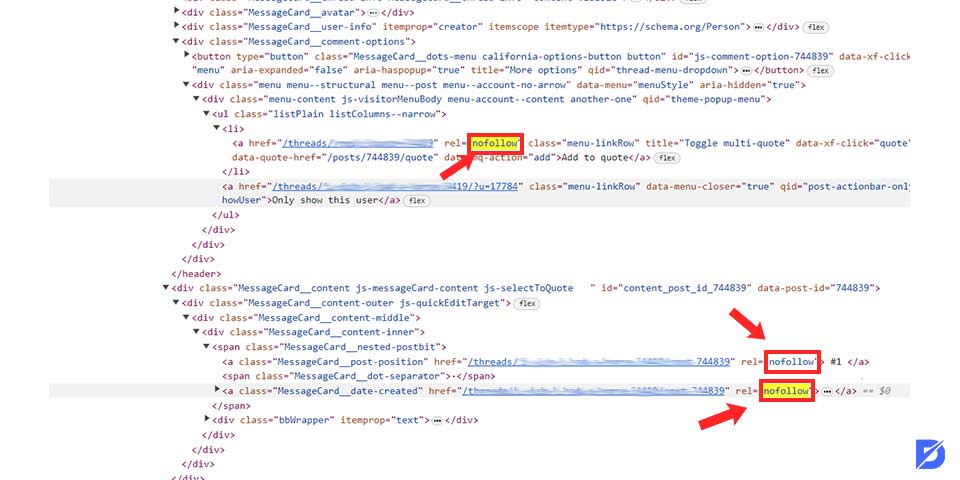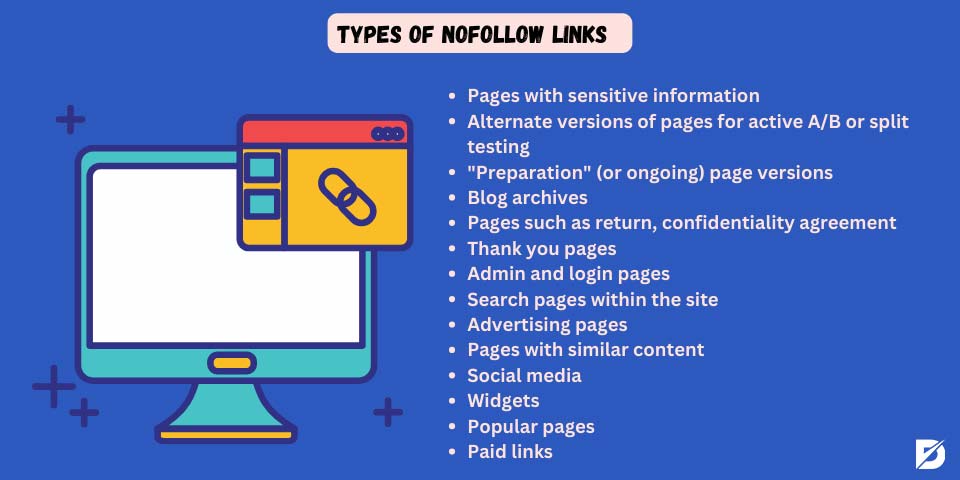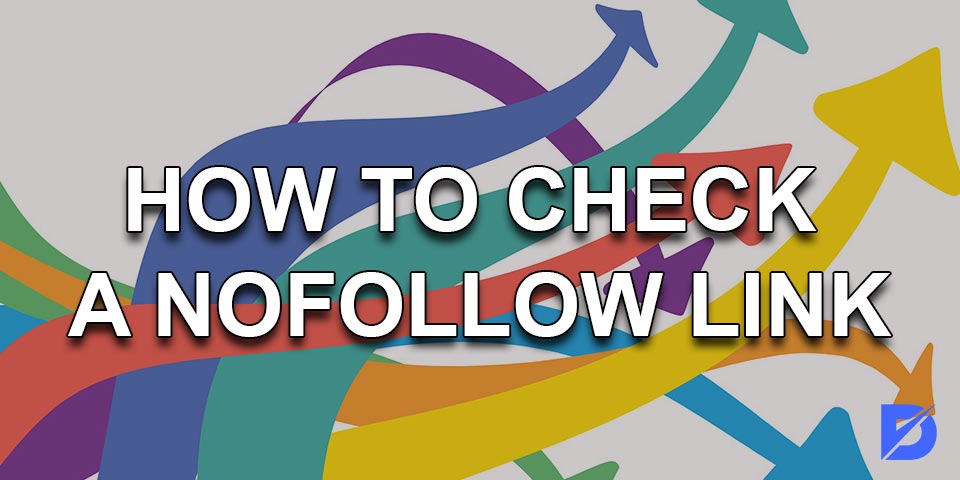In the ever-evolving landscape of SEO, terms like ‘NoFollow links’ frequently pop up, leaving many to wonder about their significance in the grand scheme of web optimization. So, what is a nofollow link? In simplest terms, it’s a type of link that instructs search engines not to consider it for search ranking purposes. While it might seem counterintuitive to have links that don’t “count” in the eyes of search engines, there’s a method to the madness. This article delves deep into the world of NoFollow links, exploring their origin, purpose, and how they fit into your SEO strategy.
What Is a NoFollow Link?
NoFollow links were introduced by Google in 2005 to overcome comment spam. These links are a hyperlink that contains a rel= “nofollow” attribute. This attribute tells search engines to ignore these links. In other words, it tells search engines not to follow the link destination.

NoFollow vs DoFollow
To understand what is going on with NoFollow links, we need to understand the difference between NoFollow and DoFollow links. According to many website users, these two types of links look exactly the same. Thus, it is impossible to understand the difference between these links for an average website user. However, there is a huge difference between them in search engine optimization. Dofollow links help you improve your search engine rankings directly. On the other side, NoFollow links don’t affect your rankings directly. Let’s look at them in more detail. We have an example below. The first one is a standard link, and the second one is a NoFollow link.
- <a href=”https://www.example.com”>Example</a>
- <a href=”https://www.example.com” rel=”nofollow”>Example</a>
If you see the rel= “nofollow” attribute in the link, it is a NoFollow; otherwise, it is followed. In order, say, any link that has the rel= “nofollow” tag is a NoFollow link. That’s it!

Benefits of NoFollow Links
You should achieve a balance between NoFollow and DoFollow links. According to some studies, it looks suspicious when a website has only DoFollow links. At this point, even if a NoFollow link doesn’t have a direct impact on your search engine rankings, it can have an indirect impact on it. That’s why you should implement these types of links to improve your website rankings indirectly. Because of this, any website should have both NoFollow and DoFollow links at the same time. Here are some reasons to use the NoFollow links:
- Paid links can be a perfect way to increase your website traffic. However, according to Google, paid links are against Google Webmaster Guidelines. It means that if you use paid links, there will always be a risk of being penalized by search engines. On the other side, NoFollow links can protect you against Google penalties.
- If you have a comment feature on your website that allows users to say what they want, you can use these links to get on well with Google because of the lack of moderation on your own site.
- NoFollow links can provide more DoFollow links to your website because they increase your website exposure. Thus, when the number of people who hear of your website increases, you will be able to obtain more dofollow links organically.
Even More Benefits
- NoFollow links are a perfect traffic source, and you can make a difference for people who visit your site and share the pages on their social media accounts. Note that more traffic on your website leads to better rankings, more engagement, and more people you can reach.
- NoFollow links also improve your domain authority. These links help you improve your domain authority because they drive traffic to your website and increase your site’s credibility.
- NoFollow links build brand awareness. It is one of the most critical factors in growing your business online.
These are a few places where you can see NoFollow links used. It is a perfect way to protect your website against spammy link comments. Besides, you will have different types of link profiles at the end of the day.
When Should You Use Nofollow Links?
As you know, in backlinks, Google can lower your SEO score if you link to harmful links or increase your SEO score if you link to useful links. If this reciprocal situation is abused, Google can take serious actions and may not even open your site in Chrome.
However, Nofollow links are also used for exceptional cases that should not be followed when giving backlinks. Search engines do not track nofollow links and do not affect your search engine rankings, but they also do not affect the search engine rankings of the site you link to. For instance, if you put a link to AAA.com’s article on your page, thinking it would be useful, and this site now starts sharing inappropriate content, Google will hold you responsible. Because by not putting the Nofollow tag, you become the guarantor of this site and when this happens, it means that your site can also be billed. You may be included in Google’s list of spammer sites, and you may not be able to attract the traffic you want to your site.

Should You Add Nofollow to Internal Links?
The nofollow tag signals the search engine not to follow a particular page. This can be very useful in certain scenarios. For example, you can ensure that the search engine bot does not follow the link in registration forms and similar forms. However, you do not need a nofollow tag on internal links. You should check the links that have the nofollow attribute and eliminate invalid uses. You can use the nofollow tag on outbound links. For example, you can add the nofollow tag to the links in the comments on your site. Google recommends using the nofollow tag, especially in paid purchased links. Because these links do not affect the ranking, when it comes to internal links, you usually want to encourage the flow of link authority between your pages to enhance the overall SEO performance of your website.
- Internal links are crucial in guiding users through your website. Adding nofollow to internal links can disrupt the natural flow of navigation for users and might not be beneficial for their overall experience.
- Search engines use internal links to navigate and index the various pages of your site. Removing the ability of search engine crawlers to follow internal links may hinder their ability to discover and index important content on your site.
- In the past, some webmasters used the nofollow attribute for internal links as a way to sculpt the flow of link authority within their site. However, search engines have evolved, and the impact of internal link sculpting through nofollow is generally considered minimal or even negligible.
- There might be specific situations where adding nofollow to internal links makes sense. For example, if you have pages with sensitive information or duplicate content that you don’t want to be indexed, you could use nofollow strategically.
What’s the Difference Between Nofollow and Noindex?
Noindex can be summarized as not indexing the relevant web page in search engines. However, it is not the case that search engines do not follow the links on the page during Noindex. Nofollow, on the other hand, can be defined as search engines not following the links at the same time. This feature makes it different from Noindex. In addition, both Noindex and Nofollow are known as settings added to the robot meta tag.
Nofollow purpose: The rel=”nofollow” attribute is applied to hyperlinks to instruct search engines not to follow the linked page. It was originally designed to combat comment spam on blogs by preventing search engines from passing authority to links within user-generated content. While Nofollow links don’t pass link authority, they can still contribute to user traffic. Additionally, search engines may still discover and index the linked pages, even though they don’t pass authority.
Noindex purpose: The “Noindex” directive is typically used in the meta tags of a webpage to instruct search engines not to index that particular page. This means that the page won’t appear in search engine results pages (SERPs). Using “Noindex” is a way to keep certain pages, such as duplicate content, private, or unimportant pages, out of search engine indexes. It is often used for pages that you don’t want to be publicly accessible through search engines.
The main differences between Nofollow and Noindex are listed below:
- Nofollow is for links, saying, “Don’t follow this link too closely.”
- Noindex is for pages saying, “Don’t show this page in search results.”
- Nofollow is about links not passing importance, while Noindex is about pages not appearing in search results.

Types of Nofollow Links
Nofollow links are commonly used to prevent the passing of authority to potentially untrustworthy or user-generated content. These types of nofollow links help website owners control how search engines see and treat their links, especially in cases where they don’t want to endorse certain pages or want to manage user-generated content. Below are a few areas where Noindex editing is commonly used.
- Pages with sensitive information
- Alternate versions of pages for active A/B or split testing
- “Preparation” (or ongoing) page versions
- Blog archives
- Pages such as return, confidentiality agreement
- Thank you pages
- Admin and login pages
- Search pages within the site
- Advertising pages
- Pages with similar content
- Social media
- Widgets
- Popular pages
- Paid links
Standard Nofollow: rel=“nofollow”
The standard way to implement a nofollow link is by using the rel=”nofollow” attribute within the HTML anchor (<a>) tag.
Example: <a href=”https://example.com” rel=”nofollow“>Visit Example</a>
In this example: href=”https://example.com”: Specifies the URL to which the link points.
rel=”nofollow”: Indicates that the link is a nofollow link. This attribute tells search engines not to pass any link authority (or “link juice”) to the linked page.
Including rel=”nofollow” is a common practice when you want to link to a page but don’t want to vouch for or endorse it in terms of search engine rankings. It’s often used for user-generated content, sponsored links, or any situation where you want to provide a link without associating your site’s authority with the linked page.
Sponsored Nofollow: rel=“sponsored”
Sponsored Nofollow example is the rel=”sponsored” attribute is used to indicate that a link is sponsored or part of an advertising arrangement. It is one of the link types introduced with the “rel” attribute for hyperlinks in HTML, alongside “nofollow” and “UGC” (user-generated content).
Example: <a href=”https://example.com” rel=”sponsored”>Sponsored Link</a>
Further, href=”https://example.com” Specifies the URL to which the link points.
rel=”sponsored”: Indicates that the link is sponsored. This attribute is used to identify links that are part of an advertising or sponsorship agreement. This helps search engines understand the nature of the link and may impact how they treat it in terms of ranking and indexing. The “sponsored” attribute is particularly useful for distinguishing between organic editorial links and those that are paid or sponsored.
UGC (User Generated Content) Nofollow: rel=“UGC”
In User-generated content nofollow (UGC), the rel=”UGC” attribute indicates that a link is within user-generated content. This is another addition to the set of link types introduced with the “rel” attribute for hyperlinks in HTML.
Example: <a href=”https://example.com” rel=”ugc”>User-Generated Content Link</a>
In addition, href=”https://example.com” Specifies the URL to which the link points.
rel=”UGC”: Indicates that the link is within user-generated content. This attribute is used to identify links that are created by users, such as in forums, comments, or other areas where users contribute content.
Including the rel=”UGC” attribute helps search engines understand that the link is part of user-generated content and may be treated differently regarding ranking and indexing.

How to Check A NoFollow Link
There are multiple methods to check if a link is NoFollow. Here are some techniques:
Check the HTML Code
It is the easiest way to check the link manually. There are two options you can choose.
First Method
- In Chrome, find the link you want to check.
- Right-click and click the ‘Inspect’ option, or you can press “Ctrl+Shift+I.”
- Look into the HTML source of the web page.
- If there is a rel= “nofollow” tag, the link is a NoFollow. However, if you don’t see the rel= “nofollow” tag, that link is DoFollow.
Second Method
- In Chrome, find the link you want to check.
- Right-click and click the ‘View Page Source’ option.
- Press control/command and F.
- Type the ‘nofollow’ word.
- If there is, the link is a NoFollow. However, if you don’t see it, that link is DoFollow.
Backlink Analysis Tools
To analyze inbound links, you can prefer to use a backlink analysis tool, such as SE Ranking, Ahrefs, SEMrush, etc. All you need to do is enter a specific URL and sit back and watch.
Nofollow Links in Short
We’ve talked about the impact of NoFollow links on search engine rankings and your SEO strategy in this post. These links are links to your own website with the rel= “nofollow” tag. Even if SEO professionals don’t share their exact views, these links can indirectly impact your search engine rankings. You can prevent spam comments and unwanted links through these links to protect your site’s SEO success.
These harmful comments and unwanted links affect your SEO results and rankings negatively. However, NoFollow links help you provide your website awareness and drive traffic to your website. You can also normalize your link profile thanks to these links. That’s why, if you use the links wisely, you can attract more organic links to your site and improve your website’s SEO.
Frequently Asked Questions About
The first option is that you can make a link NoFollow by adding the rel=” nofollow” tag in between the <a href= “https://www.example.com” and >Example</a>
The second option is that you can view the page’s HTML code if you have a blog post. Go to your blog editor and open the HTML view to edit the code directly. Find the link you wish to make NoFollow. Add the NoFollow tag. At the end, the link will look like this: <a href=”https://www.example.com” rel=”nofollow”>Example</a>
Although they look alike, there is a great difference between the two. As mentioned in the review above, Dofollow links accelerate your rankings directly while NoFollow does not.
According to some people, the best ratio is 50/50. On the other side, according to some, the best ratio is 40/60. However, there is no perfect answer. But one thing is certain. You need to try to get the correct balance of NoFollow and DoFollow links to succeed in your SEO strategy.
Most SEO tools like Ahrefs, SEMrush, or Majestic tell you how many NoFollow and DoFollow links you have.





No comments to show.